
 |
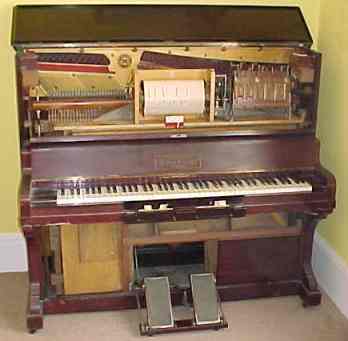 |
At its basic level, a person repeatedly presses the pedals located under the keyboard. This causes a paper roll, located above the keyboard, to turn. The paper roll has holes in it and as the holes pass a metal bar they cause hammers inside the pianola to strike the piano wires. The piano wires vibrate and they create the music. |
Pneumatic ActionThe key principle that all pianolas rely on is "pneumatic action". A pianola relies on the forces created by differences in air pressure to move objects. For example, when the air is sucked out of a pair of bellows, the atmospheric pressure outside the bellows forces them to close. A rod or lever attached to the end of the bellows can control some other action. Therefore, because a pianola relies on atmospheric pressure, it is theoretically more difficult to play a pianola at the top of a mountain, where the air pressure is lower. In outer space where there's almost no air pressure at all, it must be almost impossible to play a pianola, if you could get it out there. |
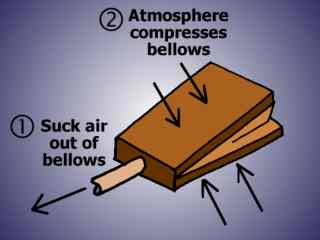 |
The key elements in a pianola are (i) the pedals and the exhaust boxes, (ii) the pneumatic motor and pianola roll, (iii) the tracker bar and vacuum chest, and (iv) the hammers and piano wires.
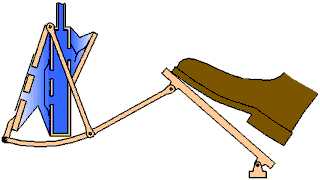 See 2D model of Pedals in Motion 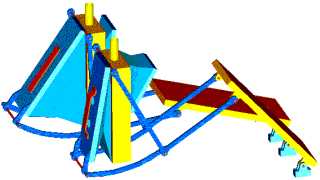 See 3D model of Pedals in Motion |
Pedals and Exhaust BoxesThere are two pedals, one for each foot. When one pedal is in the down position, the other pedal is in the up position. The player presses down on each pedal in turn. Each pedal is connected to an exhaust box. The exhaust box is a box with a large pair of bellows on one side and on the opposite side is a smaller pair of bellows with a spring inside. Pressing down on the pedal causes the larger bellows to expand and this sucks air out of the exhaust box. Atmospheric pressure then forces the larger bellows shut, and moves the pedal back to the up position. At the same time, the spring inside the smaller bellows causes the smaller bellows to expand, again sucking air out of the exhaust box. Pipes out of the top of the exhaust boxes are connect to other components inside the pianola. While the player keeps pedalling, air is continuously sucked out through these pipes. |
Pneumatic Motor and Pianola RollThe pipes out of the exhaust box connect to the pneumatic motor. The pneumatic motor converts the reduced air pressure into a circular motion which rotates the pianola roll. It does this using a sliding valve which first sucks air out of a pair of bellows so that the bellows contract. Then the valve slides to open the bellows to atmospheric pressure, and a connecting rod re-opens the bellows ready to repeat the process. Just as a combustion engine consists of a series of pistons, a series of sliding valves and bellows creates a continuous, smooth circular motion. The bellows are linked to a crank shaft which controls the position of the sliding valves and also, via gears and chains, rotates the pianola roll. |
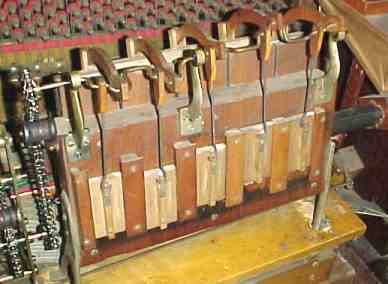 |
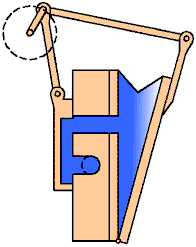 See 2D model of Pneumatic Motor |
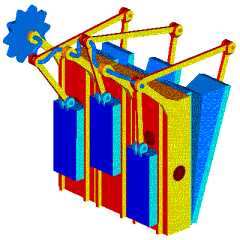 See 3D model of Pneumatic Motor |
|
A pianola roll is a long sheet of paper, rolled on to a wooden spindle. In the paper are a series of holes, one hole per note. The length of the hole determines how long the note plays. The vertical position of the hole up the paper determines when the note is played. Holes to the left of the page represent lower notes. Holes to the right of the page represent higher notes. Each pianola roll will play a different piece of music. As a pianola roll is played, the paper unrolls from its wooden spindle onto a second in-situ spindle in the pianola. Therefore you have to rewind the pianola roll back on to its original spindle before removing it. |
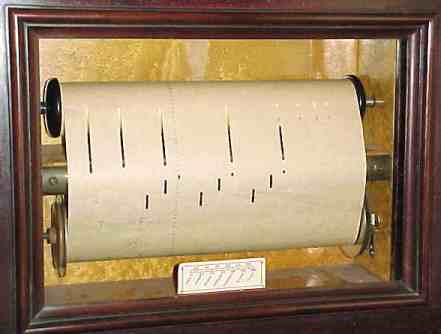 |
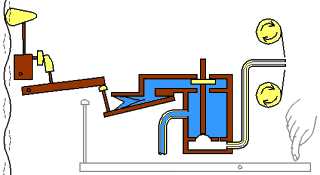 See 2D model of Vacuum Chest |
Tracker Bar and Vacuum ChestAs the pianola roll travels between the two spindles, it passes a metal bar, called the “tracker bar”. The tracker bar contains a row of small holes. There is one hole for each note. Behind each hole a pipe connects to the vacuum chest. The vacuum chest consists of a long line of twin chambers and bellows. There is one pipe, twin chamber and bellow for each note. The vacuum chest is connected to the exhaust box. Therefore, the air inside the twin chambers and pipes is initially at reduced pressure. The bellows are initially at atmospheric pressure. As a hole in the pianola roll passes the pipe in the tracker bar it causes a difference in pressure between the two chambers of the corresponding twin-chamber. Using leather pouches and discs on rods, this causes the corresponding bellows to contract. When the hole has passed by the tracker bar, the pressure difference in the twin chamber disappears. The disc and rod fall under gravity, and a spring inside the bellows expands them ready for the next note. |
The hammers and piano wires in a pianola are the same as those in an ordinary piano. However, as well as being linked to the piano keys, the hammers are also linked to the bellows controlled by the vacuum chest.
In many pianolas, the piano keys are also linked directly to the vacuum chest. When the pianola is played, the keys depress at the same time as the note plays. Therefore it appears as if an invisible person is playing the piano.
Other ComponentsA typical pianola also contains many other components which control the speed at which the pianola roll rotates, the volume of the music, and a reverse gear to enable the roll to be rewound back on to its spindle. More advanced pianolas were also able to “read” a second set of smaller holes along the edge of the pianola roll to automatically control playing speed or volume. Because pianolas evolved at a time before widespread use of electricity, usually there are no electrical components inside a piano. Also, as suitably durable and malleable plastics did not exist in the early 20th Century, pianolas were constructed mostly from wood, metal, leather, and wound cloth or rubber pipes and tubes. Unfortunately it is the rubber tubes and leather bellows which typically need repair first. |
 |
| << Back to Background and History of Pianolas | Forward to How I converted Pianola Rolls to MIDI Files >> |
| Contact Me Home Page | This page was last updated on 5th July 2006 |